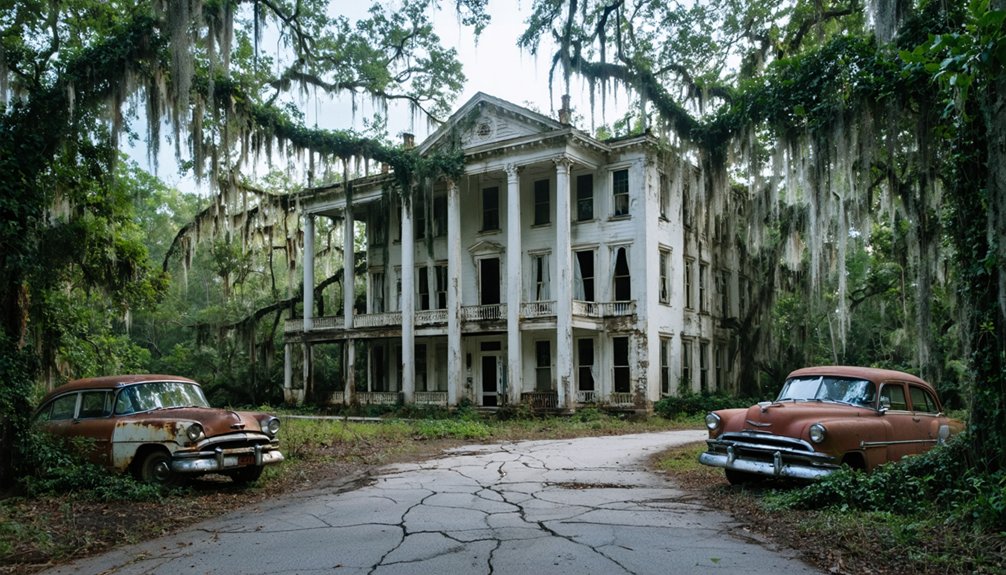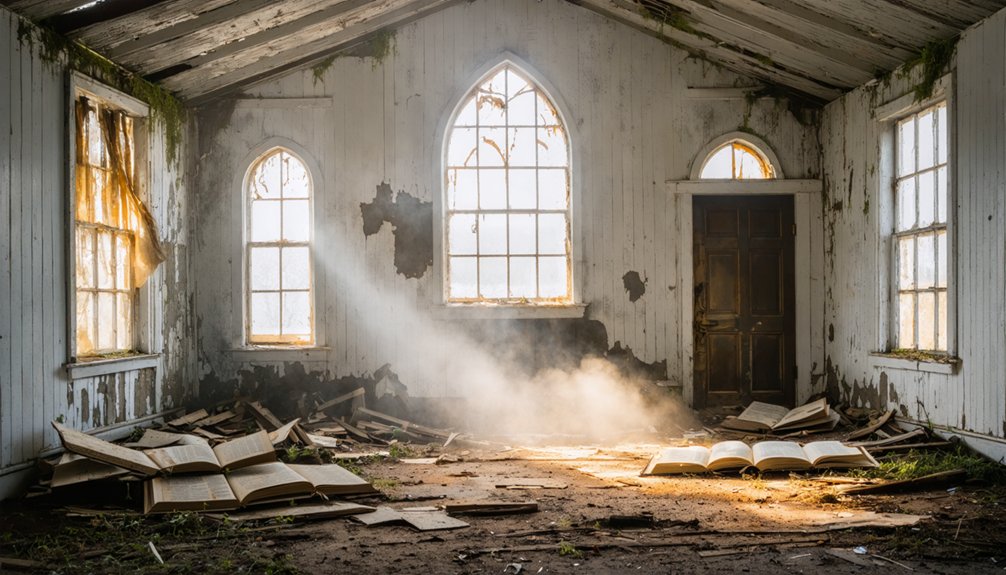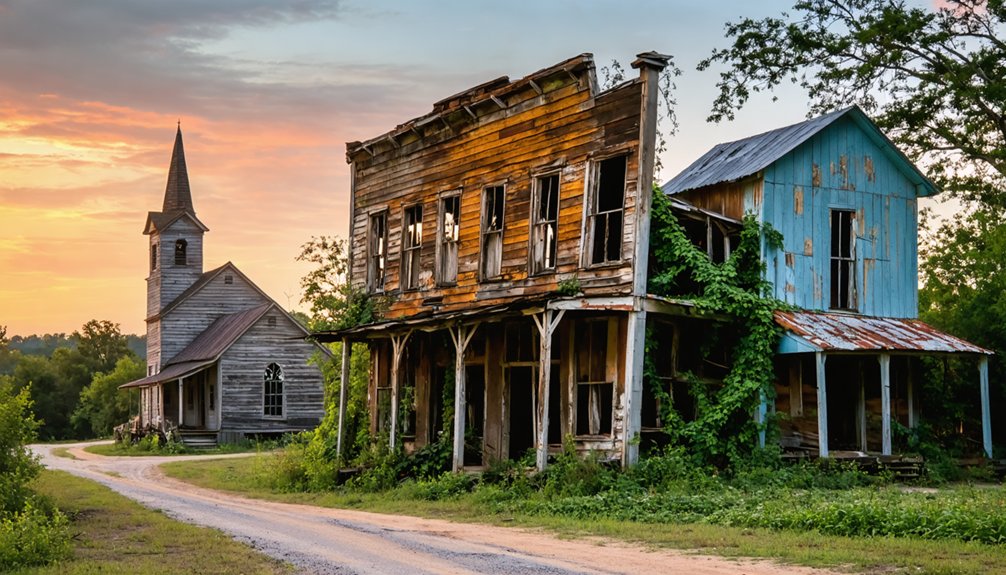Across the American South, you’ll find haunting remnants of once-thriving suburban communities now standing empty. These ghost towns emerged from economic collapse, particularly after the 2007 mortgage crisis, environmental disasters, and shifting demographics. Some neighborhoods disappeared for reservoir creation while others fell victim to foreclosures and abandonment. Local preservation efforts now race against decay to document these lost communities before they vanish completely. Their empty streets tell powerful stories of boom-and-bust cycles that continue to shape the region today.
Key Takeaways
- Post-war suburban boom in Southern states ended abruptly with the 2007 mortgage crisis, creating half-finished developments and ghost towns.
- Neighborhoods across Georgia and Alabama feature abandoned homes and military installations, offering unique glimpses into Southern history.
- Environmental disasters like floods, sinkholes, and hurricanes transformed thriving communities into uninhabited ghost towns across the South.
- Submerged towns beneath Southern reservoirs reveal communities sacrificed for development, with drought occasionally exposing their remains.
- Community-led preservation efforts through historical societies and volunteer groups document and restore these vanishing suburban landscapes.
The Rise and Fall of Southern Suburban Communities
While the American South experienced the same post-World War II suburban boom as the rest of the nation, its pattern of growth and subsequent decline followed a distinctive regional trajectory.
You’ll find these communities were built on an idealized vision—detached homes on spacious lots, promising rural tranquility with urban convenience. The GI Bill significantly fueled home ownership in these developing southern suburbs.
The suburban nostalgia that once drew families outward from city centers eventually gave way to economic reality.
The allure of suburban utopia faded when economic forces revealed the fragility of America’s residential dream.
When the 2007 subprime mortgage crisis hit, it devastated many Southern suburbs, leaving half-finished developments and vacant neighborhoods in its wake. Sunbelt cities like Atlanta, Fort Meyers, and Phoenix faced massive foreclosures that resulted in housing vacancy rates resembling those of Rustbelt areas.
This urban transformation extended beyond economics—demographic shifts, changing housing preferences, and infrastructure neglect all contributed to decline.
What began as symbols of middle-class achievement became casualties of economic volatility, with clusters of abandoned homes marking where prosperity once seemed guaranteed.
Forgotten Neighborhoods: Notable Examples Across the South
If you venture beyond the South’s more documented ghost towns, you’ll find entire neighborhoods consumed by water, including communities sacrificed for reservoir creation and coastal settlements lost to rising sea levels.
Military installations, once thriving with personnel and families, now stand abandoned across states like Georgia and Alabama, their housing quarters and facilities eerily preserved in time.
These forgotten spaces represent both deliberate governmental decisions and gradual environmental changes, offering unique windows into Southern history that few tourists ever witness.
Many of these abandoned neighborhoods have fallen victim to out-of-town speculators who purchase properties sight unseen, further accelerating their decline.
In California, the once-thriving community of Surf Ridge near LAX was completely demolished through eminent domain, with the city spending $60 million to acquire the land for airport expansion despite residents’ protests.
Historic Water-Claimed Communities
Beneath the placid waters of countless Southern reservoirs lie the remnants of once-thriving communities, sacrificed in the name of progress and development.
These drowned heritage sites—towns inundated by Tennessee Valley Authority and Corps of Engineers dam projects during the mid-20th century—represent communities displaced without choice.
When you visit these lakes today, you’re floating above lost churches, businesses, and homes.
During droughts, glimpses of this water legacy emerge—foundations and road systems briefly visible before disappearing again.
Projects like the Atlas of Drowned Towns now document these submerged histories, preserving stories of residents forced to abandon generations of cultural traditions.
The displacement disproportionately affected vulnerable populations, particularly agricultural communities whose fertile lands were permanently flooded.
These underwater ghost towns serve as sobering reminders of how infrastructure decisions can erase entire community histories.
The WikiProject Ghost Towns encourages contributors to add geographic coordinates to these submerged settlements to properly document their exact locations.
This pattern of water displacement echoes the story of California’s Tulare Lake, which first disappeared in the late 1800s when water was diverted through irrigation canals to convert indigenous lands into private farmland.
Military Bases Reclaimed
Throughout the American South, abandoned military installations stand as eerie symbols to changing national priorities and defense strategies.
Fort McClellan in Alabama epitomizes this shift; its neighborhoods of former barracks now crumble amid contamination concerns.
At Florida’s Carlstrom Field, distinctive military architecture surrenders to nature as overgrown streets wind through decaying airmen’s quarters.
Camp Gordon Johnston’s coastal WWII infrastructure has largely disappeared into Florida’s humid landscape, while Naval Air Station Lee Field presents a fascinating study in urban decay as its classic suburban layout returns to wilderness.
Maryland’s Fort Armistead, despite conversion to parkland, retains ghostly echoes of its military past with its eerie tunnels still accessible through the Battery Irons Entrance.
These bases—once thriving communities with schools, theaters, and homes—now serve as haunting reminders of how quickly our built environment can vanish when its purpose becomes obsolete.
Like many ghost towns throughout the country, these abandoned military bases have become destinations for heritage tourism, drawing visitors interested in American history and the stories of those who once lived there.
When Prosperity Fades: Economic Drivers of Abandonment
The economic collapse that triggered the abandonment of Southern suburban communities rarely occurred overnight, but rather through a cascade of interconnected failures that proved impossible to reverse.
You’ll find these ghost towns were often built around single industries—textile mills, coal mines, or manufacturing plants—leaving them vulnerable when markets shifted.
As factories shuttered, economic decline accelerated through a deadly domino effect: job losses led to suburban migration, leaving neighborhoods with 50% vacancy rates in some areas.
When employers disappeared, so did essential services—grocery stores, medical facilities, and schools.
Much like in major cities where average rent exceeds $3,000 monthly, these communities saw housing costs spiral beyond what remaining residents could afford.
Local governments, hamstrung by plummeting tax revenues, couldn’t maintain infrastructure or attract new businesses.
This boom and bust cycle mirrors historical patterns seen in places like Bodie, California, where prosperity vanished as quickly as it had arrived when gold resources were depleted.
Meanwhile, the foreclosure crisis transformed once-thriving developments into rows of empty homes, their deteriorating facades evidence of prosperity’s fragility.
Nature’s Wrath: Disaster-Driven Ghost Towns
While economic decline often leads to gradual abandonment, nature’s destructive power can transform thriving communities into ghost towns virtually overnight.
You’ll find stark examples across the South, where disaster resilience was tested beyond capacity. Port Royal, South Carolina vanished after an 1886 earthquake followed by hurricanes and coastal erosion, leaving behind only underwater remnants.
In Texas, Ben Ficklin disappeared when a catastrophic 1882 flood claimed 60 lives, forcing survivors to relocate to San Angelo. Greensburg, Kansas was completely obliterated by an EF5 tornado in 2007, while Bayou Corne, Louisiana emptied when a massive sinkhole opened in 2012.
These communities faced impossible environmental adaptation challenges when multiple disasters converged, eliminating not just buildings but the very foundation for recovery.
Preservation Efforts: Saving Southern Suburban History

You’ll find community-led restoration projects at the heart of Southern suburban ghost town preservation, where local historical societies and volunteers collaborate to stabilize deteriorating structures and document vanishing histories.
These grassroots efforts often seek funding through a combination of private donations, corporate sponsorships, and competitive preservation grants from organizations like the National Trust for Historic Preservation.
Securing historical designation status through state or national registers provides both legal protection and access to specialized funding streams that can transform abandoned properties into educational landmarks that tell the story of suburban Southern development.
Community-Led Restoration Projects
Across abandoned southern suburbs, community-led restoration projects have emerged as powerful catalysts for preserving ghost towns that might otherwise fade into obscurity.
You’ll find descendants and nearby residents forming preservation societies that transform neglect into renewal through collective action.
Community engagement thrives when you participate in needs assessments and decision-making processes that determine restoration priorities.
These collaborative approaches guarantee projects reflect local values while building legitimate, sustainable initiatives.
Volunteer efforts multiply impact—locals contribute labor, equipment, and specialized skills during weekend rebuilding events.
When you join these restoration movements, you’ll help document oral histories and artifacts that preserve intangible cultural heritage.
The most successful projects combine historically accurate restoration techniques with adaptive reuse strategies, creating spaces that honor the past while serving present community needs.
Funding Historical Designation
Securing historical designation for abandoned southern suburban communities involves maneuvering complex funding landscapes that determine which ghost towns survive and which vanish into history.
You’ll find preservation funding primarily through state and federal historic preservation offices offering targeted grant opportunities.
Local government allocations and public-private partnerships often provide the financial backbone for successful designation projects.
Don’t overlook private donations from foundations and businesses with preservation interests—these can be essential supplemental resources.
Increasingly, communities are turning to grassroots approaches like crowdfunding campaigns and local fundraising events to bridge financial gaps.
The process demands substantial investment in documentation, surveys, and public meetings, but the payoff includes tax incentives, tourism revenue, and legal protections against demolition.
Your biggest challenge remains securing sustainable funding for long-term maintenance after designation is achieved.
Urban Explorers: The Modern Appeal of Abandoned Spaces
While the abandoned towns of the South stand as silent witnesses to history, they’ve found a new purpose in recent years as magnets for urban explorers.
These forgotten pockets of suburbia offer what seasoned “urbex” enthusiasts crave: a perfect fusion of danger, nostalgia, and photographic storytelling opportunities.
Urban exploration delivers the perfect trifecta: calculated risk, emotional connection to the past, and visual narratives waiting to be captured.
You’ll find diverse motivations drawing people to these decaying spaces. Some come seeking the adrenaline rush of accessing forbidden territories, while others are driven by historical preservation interests.
The beauty of decay tells powerful stories about lost ambitions and changing economies that once sustained these communities.
Despite the growing popularity on platforms like Instagram and TikTok, remember that exploration comes with serious risks—structural hazards, legal consequences, and ethical considerations about respecting these sites.
The allure remains powerful: stepping into frozen moments of Southern history that might otherwise fade completely.
Echoes of the Past: Cultural Significance in Southern Ghost Towns

Southern ghost towns stand as powerful cultural artifacts revealing the complex racial and economic tapestry of the American South. When you explore these abandoned spaces, you’ll encounter forgotten narratives that challenge romanticized versions of history.
The cultural heritage preserved in these towns—from integrated schools in Pleasant Ridge to Mormon settlements at Zarahemla—offers profound insights into racial politics and religious minority experiences of the 19th century.
- Crumbling plantation homes whispering stories of both oppression and resistance
- Abandoned schoolhouses where Black and white children learned together against societal norms
- Cemetery headstones revealing multicultural communities erased from mainstream histories
- Architectural remains showing economic boom-and-bust cycles that shaped southern identities
- Folk narratives and ghost stories that expose competing racial narratives between Black and white southerners
Frequently Asked Questions
Are Abandoned Towns Legally Accessible to Visitors?
Abandoned towns aren’t typically accessible without permission. You’ll need to navigate legal regulations by obtaining owner consent or joining authorized tours, while prioritizing visitor safety amid structural hazards.
What Paranormal Activity Has Been Reported in These Ghost Towns?
You’ll encounter a mountain of ghostly encounters in these towns—shadow figures, spectral children, unexplained voices, and eerie phenomena like cold spots, moving objects, and mysterious lights often tied to tragic histories.
How Do Remaining Residents Feel About Living in Ghost Towns?
You’ll find remaining residents experience isolation while forming tight-knit support networks. They’re bound by nostalgic memories and community sentiments, often feeling abandoned by authorities yet fiercely attached to their homes.
Can You Purchase Property in These Abandoned Communities?
Yes, you can purchase these properties, but you’ll face complex property laws and purchasing challenges including unclear titles, limited financing options, and infrastructure concerns requiring thorough research before investing.
What Environmental Hazards Exist in Southern Ghost Towns Today?
You’ll encounter astronomical pollution levels from industrial mining waste, crumbling structures threatening collapse, toxic air contaminants, unstable ground with sinkhole risks, and contaminated water that’s created devastating wildlife risks throughout these areas.
References
- https://www.ranker.com/list/american-ghost-towns/alby-thompson
- https://en.wikipedia.org/wiki/Wikipedia:WikiProject_Ghost_towns
- https://en.wikipedia.org/wiki/List_of_ghost_towns_by_country
- https://dot.ca.gov/-/media/dot-media/programs/environmental-analysis/documents/ser/townsites-a11y.pdf
- https://devblog.batchgeo.com/ghost-towns/
- https://www.businessinsider.com/eeriest-things-seen-while-exploring-abandoned-ghost-towns-2022-10
- https://www.mentalfloss.com/geography/wanderlust/creepiest-ghost-towns-united-states
- https://en.wikipedia.org/wiki/Ghost_town
- https://www.loveexploring.com/gallerylist/101630/the-worlds-most-eerie-abandoned-towns-and-cities
- https://en.wikipedia.org/wiki/Wikipedia:WikiProject_Ghost_towns/Assessment



